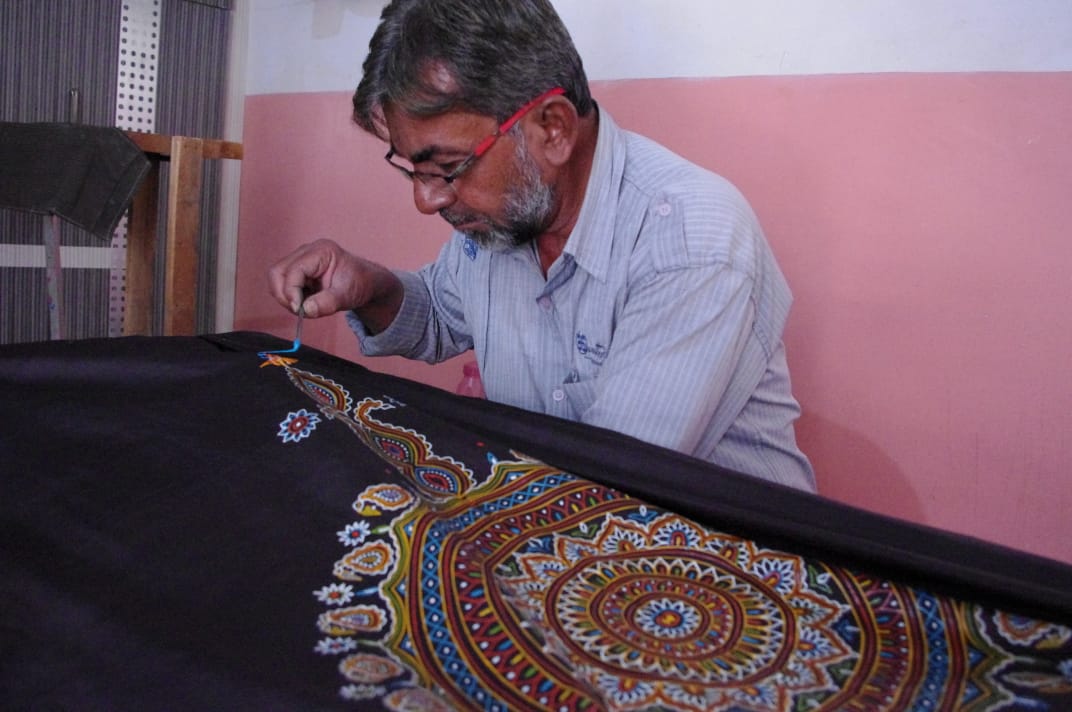Rogan’s Painting: Keeping A Dying Art Form Alive
Rogan’s Painting: Keeping A Dying Art Form Alive
Fashion students are key to the future of art
Culture
September 26, 2021
Abdul Gafur Khatri, a Padma Shri laureate, painting Rogan art on fabric (Photo: Jabbar Arab Khatri)
Rogan art is a method of textile painting, inspired by a Persian art form that arrived in the Kutch district of Gujarat about four centuries ago.
Rogan’s artwork is traditionally designed on bridal wear and wedding fabrics using vivid and rich natural colors without the use of a drawing brush.
Rogan fabric paints are produced through an arduous process. The term Rogan means “oil-based” in Persian. Firstly, castor oil is extracted from castor beans, castor oil crops are commonly grown in Kutch district. The oil is boiled for more than 12 hours periodically. The whole process takes about two days, then the heated castor oil is then mixed with cold water until it thickens into a golden brown sticky substance called Rogan.

Rogan dough is carefully twisted onto the end of the shank to create various patterns and patterns on the fabric (Photo: Jabbar Arab Khatri)
Then the next step is to add colors. The colors used in Rogan paints are natural mineral pigments which are ground with stone and then mixed with a small amount of water, adding Rogan to it using a stone pestle so that it mixes correctly colored.
“We use natural pigments to make the base strong, the chemical colors fade quickly while the natural colors will stay forever and there will also be no side effects”, Muhammad Jabbar Arab Khatri who practices Rogan art for almost 14 years in the village of Nirona. Kutch tells India Media Group.
The prepared Rogan is then immersed in water and stored in containers to prevent it from drying out and hardening.
“The whole process of converting castor oil to Rogan paste is usually done in a forest or in an isolated location because it is a dangerous process and sometimes it catches fire. We take every precaution before doing this process, but not everyone can do it safely, â€Jabbar adds.
In the past, many families in Kutch district practiced Rogan art, but now Khatri is the only family keeping the art from the brink of extinction and trying to revive the art by painting formal wear. , by organizing workshops and promoting this art form. The whole clan has been engaged in Rogan paintings for eight generations and has won several awards like Padma Shri, four national awards, three national certificates of merit and seven state awards in total, in addition to numerous international awards.
Painting on clothes
While making Rogan itself is a complicated process, painting clothes is not an easy task either. For this, the tools used by craftsmen are a rod and the palm of the hand. Before the Rogan is applied to the fabric, the paint is twisted into a fine thread and the artist places a small portion of thick paint on the palm and vigorously mixes it with a metal or a rod called a “Kalam” (or pen ) which is held in the other hand. This is mixed until the Rogan dough stretches and twists into a thin, threadlike substance.
Now the thick consistency of the Rogan dough is carefully twisted onto the tip of the rod to create various patterns and patterns on the fabric. The designs are freehand painted and the end results look like embroidery. To make a single fabric, it can take days, weeks or months depending on the models. Bright colors are used to bring out their intensity.
“Rogan’s paintings are painstakingly painted on fabrics and the metal never touches the fabric. Our own imagination plays a major role in the design and a tremendous amount of patience is required to create a uniquely designed fabric, â€explains Jabbar.
Much of this craft depends on two factors, temperature and weather conditions, as well as the consistency of the Rogan dough which also plays a major role in the design.
Bringing art back to life through the efforts of artists
Previously, Rogan paintings were the sole source of income for the inhabitants of the Kutch tribe and they received large commissions on special occasions like festivals or weddings.
But over time, with a wide availability of industrial machine-made textiles, sales of Rogan art began to suffer and artisans struggled to make a living. This forced many of them to give up their ancestral trades and look for other jobs.
However, the dying art form received a vital impetus and a push for renewal when in 2014 Prime Minister Modi presented US President Barack Obama with a Rogan artwork by Abdul Gafur Khatri, depicting the tree of Life. After that, the Khatris say they received many orders from foreign buyers as well as India.

Artist Abdul Gafur Khatri and Jabbar Arab Khatri teach students in a workshop (Photo: Jabbar Arab Khatri)
They say the government has helped them sell their paintings in several ways as well. “During the peak of Covid-19, the government helped us by placing several orders and helped us sell our products at exhibitions. In this way, they helped us to make ourselves better known in the field and it also allowed us to get a better price for our art, â€explains Jabbar.
The Khatris also started selling their fabrics on social media and, to preserve the art form, they started recruiting young artists to ensure that the art flourished. They say they began to train women and children not only from Kutch, but across India, in Rogan art.
“I have attended many workshops and taught this art in colleges, mainly students from the National Institute of Fashion Technology (NIFT) come to us to learn this art. We teach them to paint on different types of fabrics like pillow cases, tablecloths, wall hangings, saris, clothes and many decorative pieces, â€Jabbar explains.

